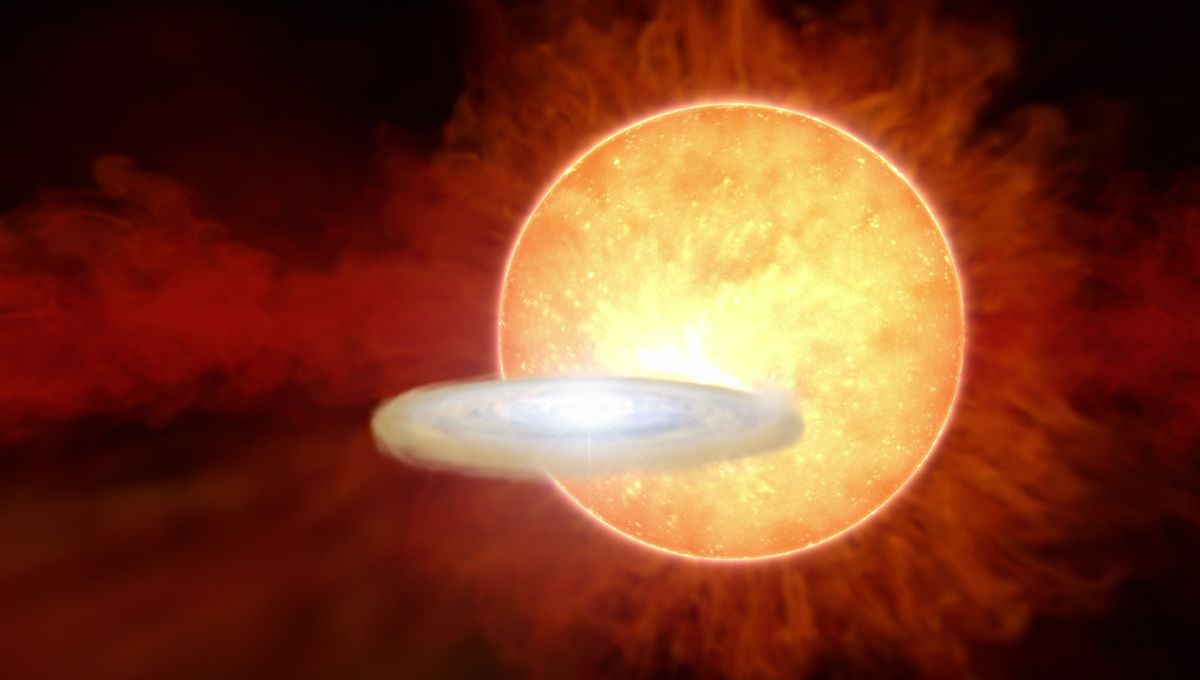
Around every 80 years, the system we call T Coronae Borealis experiences a sudden increase in brightness. It becomes up to 1,585 times brighter, something that earned it the nickname of “The Blaze Star”. But it has a more accurate name: it is a recurring nova, and it is going to get brighter again very soon.
The system is made of two very evolved stars. One is a red giant and the other a white dwarf. The white dwarf is a little thief, though. It is stealing material from the red giant and that is the cause of the nova.
A white dwarf is the end product of a star like the Sun. Once it has spent all its nuclear fuel following its transformation into a red giant, its core will contract into a dense, hot object and push away the outer layers of plasma.
This exposed core stays hot and bright and usually doesn’t do much more than that unless a companion supplies matter. In that case, the material can accumulate on the hot surface, and over the years pressure and temperature increase, until it experiences a thermonuclear reaction making a big explosion. That’s the nova.
It only affects the surface layer and as long as the supply of matter is steady, it will repeat time and time again. For T Corona Borealis, a nova was documented in 1787, 1866, and 1946. It is also believed that an even earlier eruption was recorded in a medieval manuscript from 1217.
Based on the observations from the last event, researchers are certain that the nova is imminent. Back in 2016, we reported that it started to get brighter and bluer just like it did in 1938 ahead of the 1946 eruption. On the basis of observations over the last 8 years, researchers expected it to happen most likely before September 2024 – but novae are not precise clocks.
“Predictions in astronomy tend to fall in two categories, either extremely precise – eg. when is an eclipse going to occur, down the second? – or wildly imprecise – maybe tomorrow, or maybe in a year? This particular event is in the latter category. ‘Prior to September’ is by no means a certainty. Past performance of this particular object seems to indicate it’s rather likely (at the >75% confidence level or so?) to be before then but not certain – yes, it could wait until next year,” Dr Gerard van Belle of the Lowell Observatory put to IFLScience back in July.
Despite the uncertainty on the exact explosion date, both researchers and amateur astronomers are keeping a regular eye on the constellation of Corona Borealis. Astronomers using NASA’s Fermi telescope are looking at the white dwarf daily, capturing important data on what happens before a nova erupts and hoping to catch it in the act. T Coronae Borealis is 3,000 light-years away, which is very close to us, cosmically speaking.
“There are a few recurrent novae with very short cycles, but typically, we don’t often see a repeated outburst in a human lifetime, and rarely one so relatively close to our own system,” Dr. Rebekah Hounsell, an assistant research scientist specializing in nova events at NASA’s Goddard Space Flight Center, said in a statement. “It’s incredibly exciting to have this front-row seat.”
For all the other sky lovers such as us, we just have to keep an eye out. Currently, the constellation rises in the early hours of the morning in the Northern Sky, so waiting a couple more months could make it easier for more people to see the event.
Source Link: Once-In-A-Lifetime T Coronae Borealis Nova Event Expected Soon